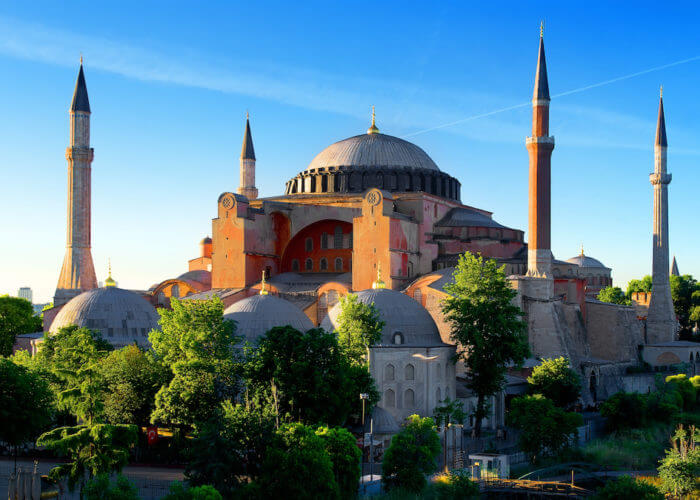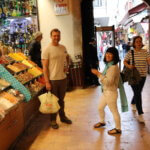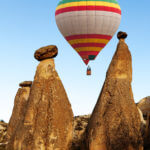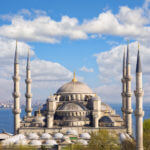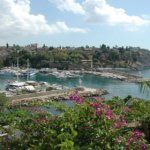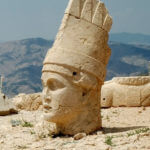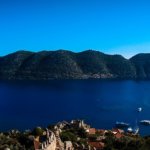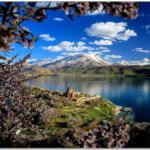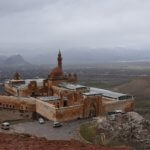Hagia Sophia
The most renowned Byzantine cathedral and the best known Christian church in Istanbul. The first church was built between 325-360. Construction was begun by Constantine and completed by his son Constantius (337-362 A.D.). Being the largest imperial church in the city, it was known as the Megalo Ekklesia. The name Hagia Sophia (Sacred wisdom) was adopted in the fifth century, and it was by this name that the cathedral continued to be known throughout the Byzantine era, being corrupted in the Turkish era to Ayasofya.
The earliest church is thought to have been a Stone-walled basilica with a timber roof. It opened its door to worship with great ceremony on 15 October 360. It was burnt down during an insurrection in the 5th century.
Theodosius II (408-450 A.D.) appointed the architect Rouginos with the task of rebuilding the church, which was rebuilt as a basilica and opened to prayer on 8 October, 415 A.D. this too was shortlived, the second church being burnt down during the Nika insurrection on 13 January, 532 A.D. Traces of this building can be seen outside the western wall of the present church. They were uncovered during excavations in 1935 at a depth of 2ms. A flight of five marble steps leading up to a porticus and from there to a narthex through three protals is clearly visible. The church was apparently 60ms. wide, although further excavation was impossible without endangering the substructure of the present building, so the length is not known.
Justinian ordered a new church built of an unprecedented size and magnificence. He appointed two of the most famous architect of the day to carry out this task: Anthemios of Tralles and Isidoras of Miletus. Only 39 days after the fire which destroyed the earlier church, work on the new church was begun. After past experience, timber was avoided in its construction. Valuable marbles were brought from all corner of the empire. Columns for the interior were brought from temples at Baalbek, Heliopolis, Ephesus and Delphi, while other pillars and capital were amde of white Proconessos, gren Tesselian, golden Lybian, pink Phrygian and ivory Cappadocian marble. The main wall, the dome, vaults and arches were built of brick. The construction took five years, with 1000 master craftsmen and 10,000 labourers working on the site. The new church was opened on 27 December 537. Leading the ceremony was the emperor Justinian, who approached the chruch in hhis ceremonial coach, and was received by the Grand Patriarch Menas. They entered the church arm in arm, according to tradition. It is said that the emperor, processing towards the apse, in a state of great excitement proclaimed his thanks to God of having the honour to have constructed such a magnificent church, and shouted ‘’Solomon, I have surpassed you.’’
Today, after repeated restoration and additions, Haghia Sophia is notably altered. Several earthquakes damaged the structure and in 558 the dome partially collased. This was rebuilt by the young Isidoros, when the dome was raised by 6.25ms, and reopened in 562. Lather repairs failed to provide the building with the static support essential for its stability. Repeated earthquakes continued to weaken the fabric and the cost of maintainance rose continuously. During the Latin invasion, the crusaders sacked and damaged Hagia Sophia, as if it were a pagan temple, in 1204. The gilded silver panels flanking the imperial portal were taken as booty by crusading soldiers, along with gold and silvercrosses and any available valuables, while crusading monks acquired what religious artefacts they could, inflicting the greatest damage ever suffered by the cathedral throughout history.
When the city was recaptured by the Paleologues in 1261, Michael VIII (1261-1282) ordered the restoration of the church by the monk and architect Ruchas. The buttress walls on the western facade date from this period. Pyramidal buttresses were later added to the northern and southern walls in 1317 to ofset the effect of the dome’s weight which was pushing out the walls. On the Turkish conquest of Istanbul in 1453, Mehmet II found the church in a state of ruin. The conqueror lead the first Friday prayers there and ordered it to be converted into a mosque. Later a mihrab was added to the eastern apse in line with the qibla, facing towards Mecca, and a wooden minaret was erected over one of the western cupolas. The main structure and mosaics on the interior were left untouched. Later, during the period of Suleyman I (1520-1566) the mosaics were plastered over. The brick mnaret on the South eastern flank and a buttress wall on the eastern facade were added during the reign of Mehmet II. The slimmer minaret on the North eastern flank was added during the reign of Bayezit II (1481-1512), while the two more solid minarets to the west were additions of the Selim II (1566-1574) period, and were consturcted by the architect Sinan.
The Ottoman sultans restored and maintained the buildings in the best possible state, embellishing it with Islamic Works of art. A muezzin’s gallery in fine marble was added to the mosque during the reign of Murat III (1574-1595). Two marble amphorae dating from the Hellenistic period were brought from Bergama and set up to either side of the portal on the inerior, which with the addition of faucets, were used for ritual washing before prayer. Two large candelabra flanking the mihrab were among the spoils of Budin, captured by Suleyman I during his Hungarian campaign. A marble mimber and the marvle pulpit set to the left of the space under the main dome were added during the reign of Murat IV (1623-1640). A library adjoining the mosque was added during the reign of Mahmut I. Finely decorated with Iznik tiles, it contained space for 30,000 books. During the same period a fountain was erected in, the mosque court, together with a school and observatory. Four sultan’s mausoleums are to be found in the eastern corner of the gardens which also contain the baptistry, later converted into a mausoleum.
The most extensive restoration at Haghia Sophia took place during the reign of Abdulmecit (1839-1861). Under the direction of the Italian architect Gaspar Fossati, the dome was stabilised by the addition of double iron band. The roof was releaded and columns moving out of ture were restored. The mosaics were uncovered and restored, those with cruciform patterns and human figures replastered, while the imperial gallery was given its present day appearance by Fossati. The restorations took two years.
The large inscrition plaques were attached to the walls at that time. They were the work of the calligrapher Izzet Efendi, who also decorated the dome with his inscription of verses from the Koran.
Hagia Sophia was declared a national monument and became a museum by order of Ataturk on 24 November 1934.
The church is entered via the western portal which leads into the exonarthex, from which five portals open into the narhtex (11×60 ms.), notable for their polychrome marble revetments.
The narthex opens into the main body of the church through nine portals, the three central portals being the imperial doors. Over the main portal is a mosaic of christ enthroned dated to the 9th century. The figure of Christ has his right hand raised in blessing, while his left hand holds up a book resting on his knee. The mosaic is flanked to right and left by the figures of the Blessed Virgin and the angel Gabriel in roundels. Prostrated before the throne is the figure of Leo VI (886-912 A.D.).
The total area of the church including its narthexes is 7570m2. It is the fourth largest church in the world. The interior is dominated by a dome 55.60 m2 in height. The dome is not quite circular, measuring 30.8m. X 31.88m., and rests on four main piers joined by four supporting arches. The drum is pierced by forty Windows. Of the surviving decortation, the cherubim in the pendentives are frescos dating to the 10th century. The mosaic of the Mother of God enthroned, bearing the Christ child in the apse dates to the 9th century.
In blind niches along the North wall are mosaic portraits of three beatified members of the clergy, the Patriarchbishop of Antalya, Ignatios and St. Ignatios Theophoros, in frontal pose on a gold ground.
In the northern nave is the so-called ‘’sweating column’’, of pourous marble. The dampness can be felt by placing the hand in a hole in the shaft which has been worn into it and is framed in bronze. Even in Byzantine times this piller was considered miracuous.
At the South of the central nave is an area of marble mosaic of fine quality. This is believed to be the spot where the Byzantine emperors were crowned and was known as the Byzantine omphalos (centre of the earth).
The church is surrounded on three sides by galleries, there being no gallery over the apse. The galleries have finely decorated ceilings and mosaics of considerable value.
The Deesis mosaic in the South gallery is dated to the 12th century. It is partially destroyed, but still its fine and delicate workmanship can be easily seen in a work of particularly small tesserae. Christ is flanked by the Virgin and John the Baptist, on a golden ground.
Set into the wall opposite is the tombstone of Enrico Dandola, Doge of Venice, dated 1205. Further along we see two mosaics of note. The mosaic to the left is dated to the 11th century and shows Christ flanked by the Empress Zoe and her third husband, the emperor Constantine IX (1042-1054). To the right is a 12th century mosaic panel portraying the Virgin and child flanked by the emperor Iohannes Comnenos II (1118-1143) and the empress Eirene. Their son Alexios is portrayed on a narrow panel on the wall to the right. His pale and wasted expression is that of a Prince who died in his twenties.
Descendign from the gallery via the imperial ramp, on emay exit from the southern portal of the narthex. The bronze door here dates from the Hellenistic era and was brought to Istanbul from a temple in Tarsus. The mosaic shows the Virgin, standing, with the Christ child in her arms. To her right the emperor Constantinus Magnus offers a model of the city, while to her left Justinianus proffers a model of the Haghia Sophia.
The gilded tesserae in the mosaics were made by spreading gold leaf over a layer of glass tesserae after which this was finished with a further layer of glass paste. This prevented the gilding from deteriorating.

